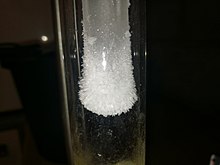Chlorobutanol
|
| |||
| Names | |||
|---|---|---|---|
|
Preferred IUPAC name
1,1,1-Trichloro-2-methylpropan-2-ol | |||
| Other names
1,1,1-Trichloro-2-methyl-2-propanol; Chlorbutol; Chloreton; Chloretone; Chlortran; Trichloro-tert-butyl alcohol; 1,1,1-Trichloro-tert-butyl alcohol; 2-(Trichloromethyl)propan-2-ol, 1,1,1-trichloro-2-methyl-2-propanol; tert-Trichlorobutyl alcohol; Trichloro-tert-butanol; Trichlorisobutylalcohol; 2,2,2-Trichloro-1,1-dimethylethanol
| |||
| Identifiers | |||
|
|||
|
3D model (JSmol)
|
|||
| ChEMBL | |||
| ChemSpider |
|
||
| ECHA InfoCard | 100.000.288 | ||
| EC Number |
|
||
| KEGG |
|
||
|
PubChem CID
|
|||
| UNII | |||
|
CompTox Dashboard (EPA)
|
|||
| |||
| |||
| Properties | |||
| C4H7Cl3O | |||
| Molar mass | 177.45 g·mol−1 | ||
| Appearance | White solid | ||
| Odor | Camphor | ||
| Melting point | 95–99 °C (203–210 °F; 368–372 K) | ||
| Boiling point | 167 °C (333 °F; 440 K) | ||
| Slightly soluble | |||
| Solubility in acetone | Soluble | ||
| Pharmacology | |||
| A04AD04 (WHO) | |||
| Hazards | |||
| Occupational safety and health (OHS/OSH): | |||
|
Main hazards
|
Xn | ||
| NFPA 704 (fire diamond) | |||
|
Except where otherwise noted, data are given for materials in their standard state (at 25 °C [77 °F], 100 kPa).
| |||
Chlorobutanol (trichloro-2-methyl-2-propanol) is a preservative, sedative, hypnotic and weak local anesthetic similar in nature to chloral hydrate. It has antibacterial and antifungal properties. Chlorobutanol is typically used at a concentration of 0.5% where it lends long term stability to multi-ingredient formulations. However, it retains antimicrobial activity at 0.05% in water. Chlorobutanol has been used in anesthesia and euthanasia of invertebrates and fishes. It is a white, volatile solid with a camphor-like odor.
Synthesis
Chlorobutanol was first synthesized in 1881 by the German chemist Conrad Willgerodt (1841–1930).
Chlorobutanol is formed by the reaction of chloroform and acetone in the presence of potassium or sodium hydroxide. It may be purified by sublimation or recrystallisation.
Toxicity
Chlorobutanol is toxic to the liver, a skin irritant and a severe eye irritant.
Parthenogenesis
Chlorobutanol has proven effective at stimulating parthenogenesis in sea urchin eggs up to the pluteus stage, possibly by increasing irritability to cause stimulation. For the eggs of the fish Oryzias latipes, however, chlorobutanol only acted as an anesthetic.
Pharmacology
It is an anesthetic with effects related to isoflurane and halothane.
External links
| Alcohols | |
|---|---|
| Barbiturates |
|
| Benzodiazepines |
|
| Carbamates | |
| Flavonoids |
|
| Imidazoles | |
| Kava constituents | |
| Monoureides | |
| Neuroactive steroids |
|
| Nonbenzodiazepines | |
| Phenols | |
| Piperidinediones | |
| Pyrazolopyridines | |
| Quinazolinones | |
| Volatiles/gases |
|
| Others/unsorted |
|
|
Receptor (ligands) |
|
||||
|---|---|---|---|---|---|
|
Transporter (blockers) |
|
||||
| Authority control: National |
|---|




